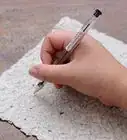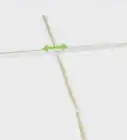This article was co-authored by Natalie Kay Smith. Natalie Kay Smith is a sustainable fashion writer and the owner of Sustainably Chic, a sustainability-focused blog. Natalie has over 5 years of sustainable fashion and green living writing and has worked with over 400 conscious brands all over the world to show readers fashion can exist responsibly and sustainably.
There are 7 references cited in this article, which can be found at the bottom of the page.
wikiHow marks an article as reader-approved once it receives enough positive feedback. This article received 11 testimonials and 100% of readers who voted found it helpful, earning it our reader-approved status.
This article has been viewed 990,096 times.
Pinwheels are a beautiful decoration and delight children of all ages. Use them to decorate your yard for a party, or happily watch your children as they admire the bright colors whirling together. Once you know how to make a basic pinwheel, you can make a fancier one with more spokes. You can also make a disc-shaped pinwheel. It won't spin, but it'll look lovely as a wall decoration or ornament.
Steps
Printable Pinwheel Template
Simple Pinwheel
-
1Start with a square sheet of paper. You can use any size of paper you want, but something around 6 inches (15.24 centimeters) will work the best.[1] Choose something colorful; double-sided scrapbooking paper will work the best because it has a design on both sides.
- Alternatively, you can use recycled toilet paper rolls.
- Use shipping paper and paint and color it.
- You can even reuse any old paper box for arts and crafts.
-
2Trace four diagonal lines from the corners of the square toward the center. Place a ruler on the paper so that it goes from the top left corner to the bottom right corner. Use the ruler as a guide to trace a neat line. Repeat this step for the top right corner and the bottom left corner.[2]
- You can also fold the paper corner-to-corner twice to make an X instead.[3]
Advertisement -
3Cut partway across each line. Stop when you are ½ to 1 inch (1.27 to 2.54 centimeters) from the center. Do not cut all the way to the center, or your pinwheel will fall apart.
-
4Bring every other corner to the center. Your paper will have short, stubby corners and long skinny ones. Make sure that you are only folding the long, skinny corners to the center. Also, make sure that the corners all overlap in the center.[4]
- Do not fold the paper. You want it to remain curved.
-
5Stick a pushpin through the center. Make sure that you catch all four corners, and that the pin goes out the middle of the paper. Rotate the pin in the paper to widen the hole.[5]
-
6Add a few small beads onto the end of the pin. You will only need 1 to 3 beads. Make sure that they are all the same size and shape. These beads will help lift the pinwheel away from the dowel and allow it to spin.
- Avoid using plastic pony beads; they are too big.
-
7Make the pilot hole in the dowel. Use a thumbtack to make the hole, about ½ inch (1.27 centimeters) down from the tip.[6] Press a thumbtack into the dowel until it sticks, then lightly strike it with a hammer. Pull it out when you are done.
- Soak the dowel in warm water for a few minutes first; this will help prevent it from breaking.
-
8Press the pinwheel into the dowel. If the pin is loose, take it out, add a bead of glue into the hole, then push it back in again. Give the pinwheel a test spin, then pull the pin out further, if needed. If part of the pushpin is sticking out of the back of the dowel, you will need to fold it down with a pair of pliers.
Fancy Pinwheel
-
1Cut a hexagon shape out of paper. Draw or print a hexagon directly on the paper you will be using. Cut the hexagon out using a pair of scissors or a metal ruler and a sharp blade.[7]
- Scrapbooking paper works especially well for this, especially the double-sides kind.
-
2Connect all of the corners so that they meet in the center. Use a ruler and a pencil to trace lines from corner-to-corner on you hexagon. When you are done, you will have a * shape in the center.[8]
-
3Cut partway along each line. Stop when you are about a third of the way from the center. Do not cut across the lines all the way to the middle, or the hexagon will fall apart.[9]
-
4Fold every other corner to the center. Start at the top, and work your way around in a circle until you are back where you are started. Make sure that the corners overlap in the middle of the pinwheel. Do not crease or bend the paper, however; you want to keep those nice curves![10]
-
5Push a pin through the center of the pinwheel. Make sure that you catch all of the folded-over corners. Have the tip of the pin come out the back of the pinwheel. Wiggle the pin a little to help widen and loosen the hole.
-
6Add a couple of beads onto the pin. You only need 1 to 3 beads. These will help lift the pinwheel away from the dowel and allow it to spin. Avoid using large beads, like pony beads, however.
-
7Make a pilot hole in the top of the dowel. Use a thumbtack to punch a hole in the dowel, ½ inch (1.27 centimeters) away from the tip. If you need to, use a hammer to help drive the thumbtack into dowel, then pull the thumbtack out.
-
8Push the pinwheel into the dowel. Give the pinwheel a test spin. If it gets stuck, pull the pushpin out a little further. If the pushpin comes out of the back of the dowel, bend it down with some pliers or a hammer. If the pin is too loose, pull it out, add some glue into the hole, then push it back in again.
Decorative Pinwheel
-
1Cut a sheet of patterned scrapbooking paper into four strips. Get some 12-inch (30.48-centimeter) square scrapbooking paper. Use a metal ruler and a craft blade to cut the paper into four, 3-inch (7.62-centimeter) wide strips.[11]
- Some scrapbooking paper has a white strip along the bottom edge for the price and label. You should trim this off first.
- These pinwheels are meant to be used as decorations on gifts, walls, or ornaments. They do not spin like regular pinwheels.
-
2Fan-fold the strips widthwise. Take your first strip, and fold the narrow edge over by ½ to 1-inch (1.27 to 2.54 centimeters). Use that as a fold as a guide for the rest of the paper. Repeat this step for the remaining three strips.[12]
-
3Consider adding a design to one of the long edges. Fold your strip back up so that it looks like a closed fan. Cut an angle into one of the narrow edges. Work one strip at a time, otherwise, the paper will be too thick to cut neatly.[13]
- You don't have to do this step. This will simply give the pinwheels a more ornate edge.
-
4Attach the pieces together to make a longer strip. Place a strip of tape against one of the narrow ends of your first strip. Place it against the narrow end of the next strip, then press them together. Keep connecting the strips until you have one long strip.[14]
- If both ends of the strips are folded in opposite directions, they will make a V or ^ shape. Trim off one of the ends until both are folded in the same direction.
-
5Attach the first and last strips together to make a disk. Run some glue or a strip of double-sided tape along one of the narrow ends. Bring the other narrow end towards it, and press the two together.[15]
-
6Flatten the disk. If the disk won't lay flat, you will need to glue a support to the back. Flip the disk over so that the back is facing you. Choose a dowel, straw, or skewer that is the same height as the disk. Hot glue your chosen stick down the center of the disk, right between two ridges.[16]
-
7How glue an embellishment to the front of the disk. For a fancy look, you can cut a small circle out of coordinating paper, then glue it to the front to cover the hole.[17] For a more rustic touch, you can use a large button instead.
-
8Cut a circle cut from cardstock to the back of the pinwheel. This will make it easier to secure the pinwheel to walls, gifts, and other items. It would be best if you use a matching color, but you can use a different color as well.[18]
- Use a cup, jar, or lid to trace the circle.
-
9Use double-sided tape to secure the pinwheel. Place a few strips of double-sides tape onto the back of the pinwheel, right over the cardstock circle. Secure the pinwheel to your desired gift of banner.
- If you are securing the pinwheel to a wall, consider using double-sided, foam mounting tape instead.
- Alternatively, you can string several pinwheels together to make a banner.
-
10Finished.
Community Q&A
-
QuestionWhy do I glue and not tape?
 Community AnswerYou could tape, but glue will ensure longevity and durability. It also makes for a more even weight distribution.
Community AnswerYou could tape, but glue will ensure longevity and durability. It also makes for a more even weight distribution. -
QuestionHow do I make a pinwheel without a map pin?
 Community AnswerYou can't. You don't need a map pin specifically, but without some kind of pin, your pinwheel won't stay together.
Community AnswerYou can't. You don't need a map pin specifically, but without some kind of pin, your pinwheel won't stay together. -
QuestionHow long does the paper last on the pinwheel?
 Community AnswerIt can last a long time if you keep it indoors. Do not let it fade in the sun or get wet.
Community AnswerIt can last a long time if you keep it indoors. Do not let it fade in the sun or get wet.
wikiHow Video: How to Make a Pinwheel
Things You'll Need
Making a Simple Pinwheel
- Colorful paper
- Pencil
- Ruler
- Scissors
- Pushpin
- Small beads
- Thumbtack
- Hammer (if needed)
- Short, thin dowel
Making a Fancy Pinwheel
- Colorful paper
- Pencil
- Ruler
- Scissors
- Pushpin
- Small beads
- Thumbtack
- Hammer (if needed)
- Short, thin dowel
Making a Pinwheel Decoration
- Colorful paper
- Pencil
- Ruler
- Scissors
- Double-sided tape
- Hot glue gun and hot glue sticks
- Stapler
- Cardboard scraps or buttons
References
- ↑ https://www.oncewed.com/diy/diy-wedding-pinwheel/
- ↑ https://www.oncewed.com/diy/diy-wedding-pinwheel/
- ↑ http://www.leslietryon.com/3dcolorcutout/makepinw/makepinwheel.html
- ↑ http://www.leslietryon.com/3dcolorcutout/makepinw/makepinwheel.html
- ↑ http://www.leslietryon.com/3dcolorcutout/makepinw/makepinwheel.html
- ↑ https://www.oncewed.com/diy/diy-wedding-pinwheel/
- ↑ https://spaceplace.nasa.gov/pinwheel-galaxy/en/
- ↑ https://spaceplace.nasa.gov/pinwheel-galaxy/en/
- ↑ https://spaceplace.nasa.gov/pinwheel-galaxy/en/
- ↑ https://spaceplace.nasa.gov/pinwheel-galaxy/en/
- ↑ http://www.dreamgreendiy.com/2013/06/05/a-diy-paper-pinwheel-tutorial/
- ↑ http://www.dreamgreendiy.com/2013/06/05/a-diy-paper-pinwheel-tutorial/
- ↑ http://www.designimprovised.com/2012/09/how-to-make-paper-pinwheels-easy-way.html
- ↑ http://www.dreamgreendiy.com/2013/06/05/a-diy-paper-pinwheel-tutorial/
- ↑ http://www.designimprovised.com/2012/09/how-to-make-paper-pinwheels-easy-way.html
- ↑ http://www.dreamgreendiy.com/2013/06/05/a-diy-paper-pinwheel-tutorial/
- ↑ http://www.designimprovised.com/2012/09/how-to-make-paper-pinwheels-easy-way.html
- ↑ http://www.designimprovised.com/2012/09/how-to-make-paper-pinwheels-easy-way.html
- ↑ http://www.goodhousekeeping.com/holidays/a18627/fourth-of-july-pinwheel-craft/
- ↑ https://www.papersource.com/blog/diy/how-to-paper-pinwheels/
- ↑ https://www.papersource.com/blog/diy/how-to-paper-pinwheels/
About This Article
To make a pinwheel, first collect your materials. You'll need a piece of square, colorful paper, a pencil, a ruler, scissors, a dowel, a push-pin, a small bead, a thumbtack, a hammer, and some pliers. Double-sided scrapbooking paper works best because it has designs on both sides. Trace diagonal lines from the center of the paper to every corner using a pencil and a ruler. Then, cut along each line with scissors, stopping about ½ inch from the center. Bring every other corner to the center of the square paper. Make sure the curved ends of the corners overlap. Next, secure the corners with a pushpin, then put 1 small bead onto the end of the pin. This will lift the pinwheel away from the dowel and allow it to spin. Make a hole in the dowel by pressing a thumbtack into it and lightly hitting the tack with a hammer. Remove the tack and press the pinwheel into the dowel. Finally, fold down the sharp part of the pin with pliers. For a more complex pinwheel, use a hexagon shaped piece of paper instead of a square. Trace and cut the lines just like you would for a simple pinwheel. Then, fold every single corner to the center of the hexagon paper and secure with a pushpin. Finally, attach the pinwheel to the dowel, and enjoy! For other ways to make a pinwheel, including how to make a pinwheel out of a hexagon shape, read on!

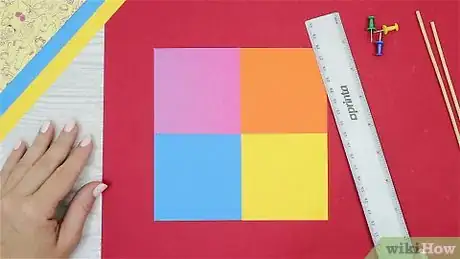

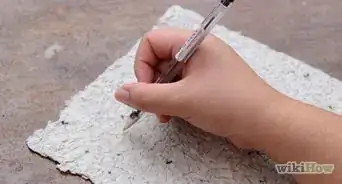
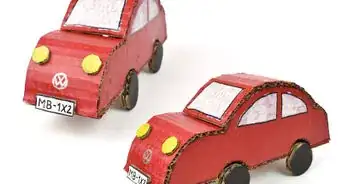










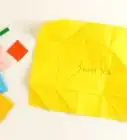
-Step-10-Version-2.webp)
